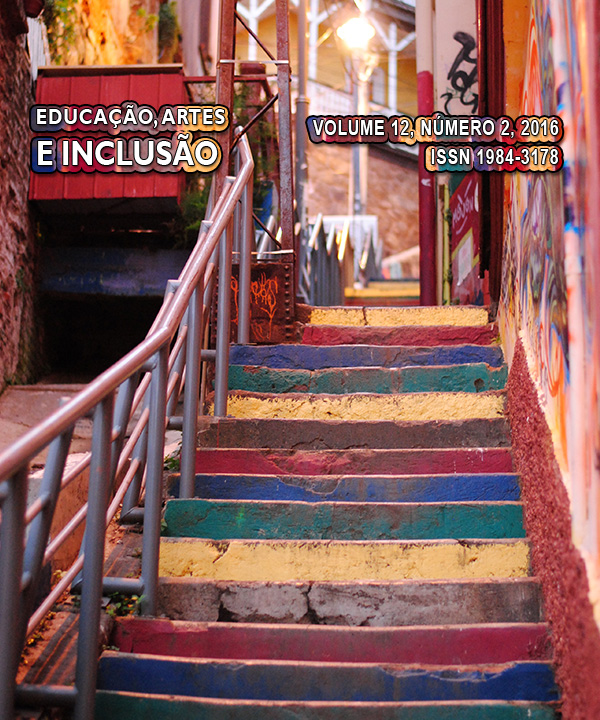NAS TRILHAS HISTÓRICAS DOS SÍMBOLOS RELIGIOSOS DA ARTE NEGRA
Keywords:
arte negra, diaspora, historiaAbstract
O artigo apresenta reflexões sobre a arte afro religiosa produzida na diáspora. O objetivo foi apresentar como as tradições compartilhadas nas formas culturais e conceitos religiosos de algumas regiões africanas foram representadas na arte negra diaspórica, destacando, ainda, os rastros destas tradições na produção artística do Brasil.Downloads
References
CADERNO de Visitas do Museu Afro Brasil. São Paulo: Via Impressa Edições de Arte, 2006.
CONDURU, Roberto. Arte Afro-brasileira: Orientações Pedagógicas. Belo Horizonte: C/Arte, 2007.
CUNHA, Marcelo N. Bernardo da. et al. Nina Rodrigues e a Constituição do Campo da História da Arte Negra no Brasil In: Gazeta Médica da Bahia 2006;76:
CUNHA, Mariano Carneiro da. Arte Afro-brasileira. In: ZANINI, W. (Coord.) História Geral da Arte no Brasil. Vol.2. São Paulo: Instituto Walter Moreira Salles, 1983.
COSTA E SILVA, Alberto. Uma visão brasileira da escultura tradicional africana. In Arte da África, Obras Primas do Museu Etnológico de Berlim. São Paulo: Centro Cultural Banco do Brasil, 2004.
GLISSANT, Edouard . Uma introdução a poética da diversidade. Juiz de Fora, UFJF, 2005.
LOPES, Maria Aparecida de Oliveira. Museu afro Brasil: ampliando e preservando os bens materiais e imateriais da cultura afro-brasileira. Revista Patrimônio e Memória. v.4, n.1, Unesp: 2008.
PAULINO, Rosana. Imagens de Sombras. São Paulo, Tese de Doutorado, USP, 2010.
Plano Nacional de Implementação das diretrizes curriculares nacionais para a educação das relações etnicorraciais e para o ensino de historia e cultura afro-brasileira e africana. Brasilia, MEC-SECAD, 2004.
RAMOS, Arthur. Arte negra no Brasil. In: ARAÚJO, Emanoel (Org.). A mão Afro-brasileira: Significado da contribuição artística e histórica. São Paulo: Tenenge, 1988.
SALUM, Marta Heloísa Leuba. Cem anos de arte afro-brasileira. In: AGUIAR, Nelson (Org.) Mostra do Redescobrimento: Arte Afrobrasileira. São Paulo: Associação Brasil 500 Anos Artes Visuais, 2000.
SALUM, Marta Heloísa Leuba. “Imaginários negros”: Negritude e Africanidade na Arte Plástica Brasileira”. In: MUNANGA, Kabengele (Org.) História do negro no Brasil: o negro na sociedade brasileira, Vol. 1 – Brasília: Fundação Cultural Palmares, 2004.
SANTOS, Milton da Silva e RIGONI, Ana Carolina Capellini. Sobre os cuidados do corpo e do espirito em livros de ensino religioso: da estética corporal aos simbolismos rituais. Debates do NER, Porto Alegre, ano 16, n 28, 2015, p. 273-296.
SANTOS, Myrian Sepúlveda dos. Entre o tronco e os Atabaques: a representação do negro nos Museus Brasileiros. Colóquio Internacional Projeto UNESCO: 50 anos depois. Salvador, 2004.
SILVA, Vagner Gonçalves da. Arte religiosa afro-brasileira: as múltiplas estéticas da devoção brasileira. In: Debates do Ner, Porto Alegre, Ano 9, N. 13, P. 97-113, JAN./JUN. 2008
SOUZA, Patricia Ricardo. Axos e Ileques: rito, mito e estética no candomblé. Tese de Doutorado em Sociologia, USP, 2007.
THOMPSON, Robert. Farris. Flash of the spirit, arte e filosofia africana e afro americana. São Paulo: Museu Afro Brasil, 2011.
Downloads
Published
How to Cite
Issue
Section
License
Copyright Statement
The Educação, Artes e Inclusão is a journal that follows the Free Access Policy. The articles published by the journal are free of charge, intended for educational and non-commercial applications. The articles whose authors are identified represent the expression from the point of view of their authors and not the official position of the Educação, Artes e Inclusão Journal or the Educação, Artes e Inclusão Research Group.
Authors who publish in this journal agree to the following terms:
(A) Authors retain the copyright and grant the journal the right of first publication, with the work simultaneously licensed under the Creative Commons Attribution License which allows the sharing of the work with acknowledgment of authorship and initial publication in this magazine.
(B) Authors are authorized to take additional contracts separately, for non-exclusive distribution of the version of the work published in this journal (eg publish in institutional repository or as a book chapter), with acknowledgment of authorship and initial publication in this magazine.
(C) This journal provides public access to all of its content, as this allows for greater visibility and scope of published articles and reviews. For more information on this approach, visit the Public Knowledge Project.
This journal is licensed under a Creative Commons Attribution-NonCommercial-ShareAlike 4.0 International License. This license allows others to remix, adapt and create from your work for non-commercial purposes, and although new work must give you due credit and cannot be used for business purposes, users do not have to license such derivative works under the same terms.



